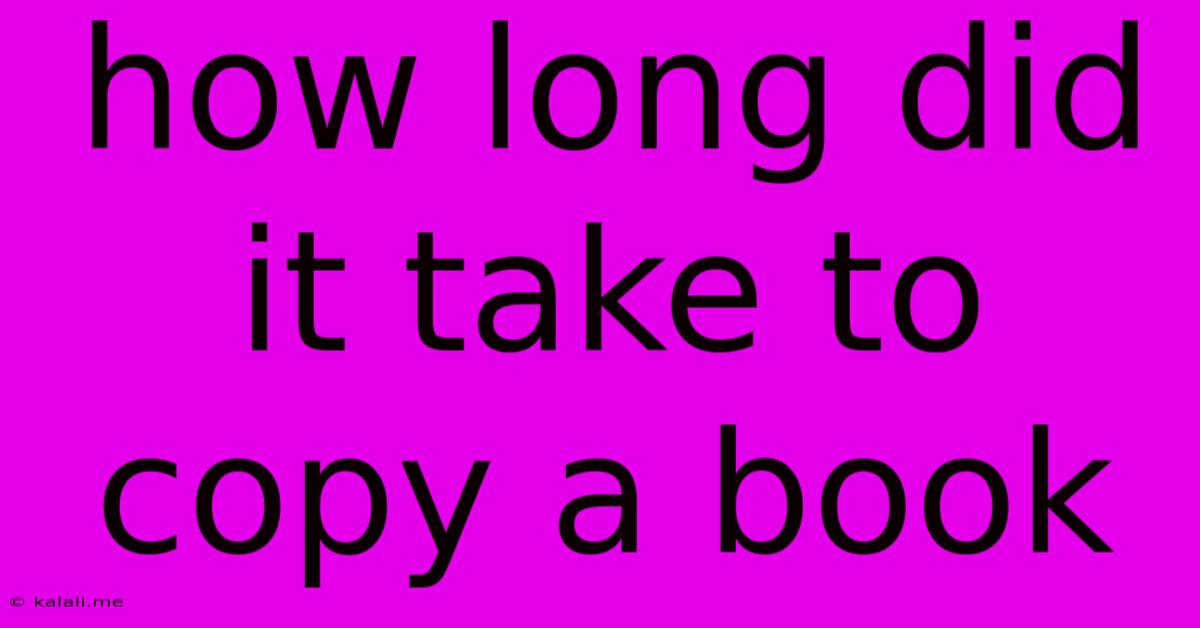How Long Did It Take To Copy A Book
Kalali
May 23, 2025 · 3 min read

Table of Contents
How Long Did It Take to Copy a Book? A Journey Through Scribal History
Before the printing press revolutionized information dissemination, copying a book was a painstaking and time-consuming process. The time it took to copy a book varied drastically depending on several factors, including the length of the book, the skill of the scribe, the script used, the availability of resources, and the purpose of the copy. This article delves into the fascinating history of book copying and explores the significant time investment involved.
The Medieval Monk and the Manuscript: A Slow and Steady Process
In the medieval period, monastic scriptoria were the primary centers for book production. Monks, often highly skilled scribes, meticulously copied religious texts, classical literature, and other important documents. Copying a single book could take months, even years. Consider these factors:
-
Calligraphy and Illumination: The creation of beautiful and legible script was paramount. Intricate calligraphy, often accompanied by elaborate illuminations (decorative illustrations), added significantly to the overall time commitment. A richly decorated manuscript could take a team of scribes and artists several years to complete.
-
The Length of the Text: Naturally, longer books took longer to copy. A small devotional text might take weeks, whereas a lengthy chronicle or theological treatise could easily occupy a scribe for several years.
-
Materials and Tools: Preparing the materials—parchment or vellum (animal skin) – was itself a lengthy process. Scribes also needed high-quality quills, ink, and other tools, the procurement of which could impact the overall timeframe.
-
Accuracy and Revision: Scribes took immense pride in their work, emphasizing accuracy. Errors were meticulously corrected, often leading to revisions and re-copying of sections. This process added considerable time.
Beyond the Monastery: Scribes in the Secular World
Outside of monasteries, secular scribes also copied books, though their work often differed in style and purpose. While the same factors—length of text, script, and skill—remained crucial, the time investment might vary based on the client's requirements. A quick, functional copy for a lawyer might take less time than a luxury manuscript for a wealthy patron.
The Impact of Script and Language
The type of script significantly affected copying speed. Simple, uncial scripts were faster to copy than more elaborate gothic or cursive scripts. The complexity of the language also played a role. Copying a text in Latin, for instance, might be faster for a skilled scribe than a text in a less familiar language.
The Printing Press: A Revolutionary Shift
The invention of the printing press in the mid-15th century marked a paradigm shift in book production. While the initial process of setting type was still laborious, the speed and efficiency of printing drastically reduced the time required to produce multiple copies of a book. What once took years could now be accomplished in weeks or months, making books far more accessible and affordable.
In Conclusion
The time it took to copy a book before the printing press was highly variable, ranging from weeks to several years. The skill of the scribe, the length and complexity of the text, the quality of materials, and the purpose of the copy all played significant roles. Understanding this long and arduous process helps us appreciate the value and significance of handwritten manuscripts and the revolutionary impact of the printing press.
Latest Posts
Latest Posts
-
Are Yellow Potatoes The Same As Yukon Gold
May 23, 2025
-
How To Get Olive Oil Out Of Clothes
May 23, 2025
-
Does Vbos Increase Fps Witha Good Gpu
May 23, 2025
-
How Did Howard Find Out Jimmy Throw The Bowling Balls
May 23, 2025
-
Can I Bring A Lighter On A Plane
May 23, 2025
Related Post
Thank you for visiting our website which covers about How Long Did It Take To Copy A Book . We hope the information provided has been useful to you. Feel free to contact us if you have any questions or need further assistance. See you next time and don't miss to bookmark.